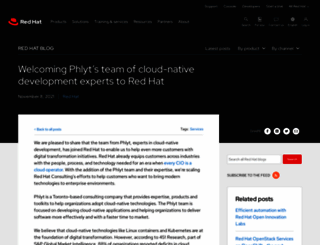Welcoming Phlyt’s team of cloud-native development experts to Red Hat
Page Load Speed
3.2 sec in total
First Response
1.5 sec
Resources Loaded
1.5 sec
Page Rendered
62 ms

About Website
Visit phlyt.io now to see the best up-to-date Phlyt content for United States and also check out these interesting facts you probably never knew about phlyt.io
We are pleased to share that the team from Phlyt, experts in cloud-native development, has joined Red Hat to enable us to help even more customers with digital transformation initiatives.
Visit phlyt.ioKey Findings
We analyzed Phlyt.io page load time and found that the first response time was 1.5 sec and then it took 1.6 sec to load all DOM resources and completely render a web page. This is quite a good result, as only 30% of websites can load faster.